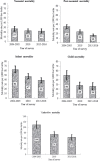Determinants of trends in neonatal, post-neonatal, infant, child and under-five mortalities in Tanzania from 2004 to 2016
- PMID: 31500599
- PMCID: PMC6734430
- DOI: 10.1186/s12889-019-7547-x
Determinants of trends in neonatal, post-neonatal, infant, child and under-five mortalities in Tanzania from 2004 to 2016
Abstract
Background: Under-five mortality is still a major health issue in many developing countries like Tanzania. To achieve the Sustainable Development Goal target of ending preventable child deaths in Tanzania, a detailed understanding of the risk factors for under-five deaths is essential to guide targeted interventions. This study aimed to investigate trends and determinants of neonatal, post-neonatal, infant, child and under-five mortalities in Tanzania from 2004 to 2016.
Methods: The study used combined data from the 2004-2005, 2010 and 2015-2016 Tanzania Demographic and Health Surveys, with a sample of 25,951 singletons live births and 1585 under-five deaths. We calculated age-specific mortality rates, followed by an assessment of trends and determinants (community, socioeconomic, individual and health service) of neonatal, postneonatal, infant, child and under-five mortalities in Cox regression models. The models adjusted for potential confounders, clustering and sampling weights.
Results: Between 2004 and 2016, we found that neonatal mortality rate remained unchanged, while postneonatal mortality and child mortality rates have halved in Tanzania. Infant mortality and under-five mortality rates have also declined. Mothers who gave births through caesarean section, younger mothers (< 20 years), mothers who perceived their babies to be small or very small and those with fourth or higher birth rank and a short preceding birth interval (≤2 years) reported higher risk of neonatal, postneonatal and infant mortalities.
Conclusion: Our study suggests that there was increased survival of children under-5 years in Tanzania driven by significant improvements in postneonatal, infant and child survival rates. However, there remains unfinished work in ending preventable child deaths in Tanzania.
Keywords: Child; Infant; Mortality, Tanzania; Neonatal; Under-five.
Conflict of interest statement
The authors have declared that no competing interests exist. FAO is a member of the editorial board (Associate Editor) of BMC Public Health but did not play any role in the peer-review and decision making process for this manuscript.
Figures
Similar articles
-
The determinants of infant and child mortality in Tanzania.Health Policy Plan. 1995 Dec;10(4):384-94. doi: 10.1093/heapol/10.4.384. Health Policy Plan. 1995. PMID: 10154361 Review.
-
Early-Neonatal, Late-Neonatal, Postneonatal, and Child Mortality Rates Across India, 1993-2021.JAMA Netw Open. 2024 May 1;7(5):e2410046. doi: 10.1001/jamanetworkopen.2024.10046. JAMA Netw Open. 2024. PMID: 38728034 Free PMC article.
-
Neonatal, postneonatal, childhood, and under-5 mortality for 187 countries, 1970-2010: a systematic analysis of progress towards Millennium Development Goal 4.Lancet. 2010 Jun 5;375(9730):1988-2008. doi: 10.1016/S0140-6736(10)60703-9. Epub 2010 May 27. Lancet. 2010. PMID: 20546887
-
Birth spacing and child survival in rural Senegal.Int J Epidemiol. 1996 Oct;25(5):989-97. doi: 10.1093/ije/25.5.989. Int J Epidemiol. 1996. PMID: 8921485
-
Mapping under-5 and neonatal mortality in Africa, 2000-15: a baseline analysis for the Sustainable Development Goals.Lancet. 2017 Nov 11;390(10108):2171-2182. doi: 10.1016/S0140-6736(17)31758-0. Epub 2017 Sep 25. Lancet. 2017. PMID: 28958464 Free PMC article. Review.
Cited by
-
Perspectives of Muslim Religious Leaders to Shape an Educational Intervention About Family Planning in Rural Tanzania: A Qualitative Study.Glob Health Sci Pract. 2023 Feb 28;11(1):e2200204. doi: 10.9745/GHSP-D-22-00204. Print 2023 Feb 28. Glob Health Sci Pract. 2023. PMID: 36853642 Free PMC article.
-
Factors associated with post-neonatal mortality in Ethiopia: Using the 2019 Ethiopia mini demographic and health survey.PLoS One. 2022 Jul 27;17(7):e0272016. doi: 10.1371/journal.pone.0272016. eCollection 2022. PLoS One. 2022. PMID: 35895632 Free PMC article.
-
Predictive model and determinants of odds of neonates dying within 28 days of life in Ghana.Health Sci Rep. 2021 Feb 15;4(1):e248. doi: 10.1002/hsr2.248. eCollection 2021 Mar. Health Sci Rep. 2021. PMID: 33614984 Free PMC article.
-
Sex inequality in under-five deaths and associated factors in low and middle-income countries: a Fairlie decomposition analysis.BMC Public Health. 2022 Feb 16;22(1):334. doi: 10.1186/s12889-022-12679-y. BMC Public Health. 2022. PMID: 35172780 Free PMC article.
-
Effectiveness of an Early Skin-to-Skin Contact Program for Pregnant Women with Cesarean Section: A Quasi-Experimental Trial.Int J Environ Res Public Health. 2023 May 9;20(10):5772. doi: 10.3390/ijerph20105772. Int J Environ Res Public Health. 2023. PMID: 37239500 Free PMC article.
References
-
- The Demographic and Health Survey Program . Infant and child mortality Online: DHS. 2019.
-
- Haidong W, Amanuel AA, Kalkidan HA, Cristiana A, Kaja MA, Foad A-A, et al. Global, regional, and national under-5 mortality, adult mortality, age-specific mortality, and life expectancy, 1970–2016: a systematic analysis for the global burden of disease study 2016. Lancet. 2017;390:1084–1150. doi: 10.1016/S0140-6736(17)31833-0. - DOI - PMC - PubMed
-
- Institute for Health Metrics and Evaluation (IHME) Financing Global Health 2016: development assistance, public and private health spending for the pursuit of universal health coverage. Seattle: IHME; 2017.
-
- United Nations . Sustainable Development - knowledge platform: United Nations. 2017.
MeSH terms
Grants and funding
LinkOut - more resources
Full Text Sources


